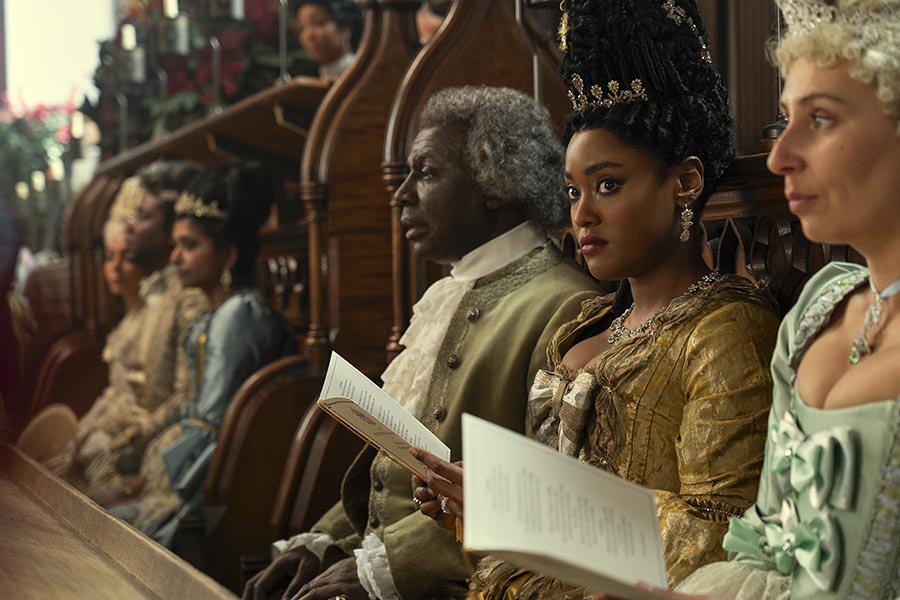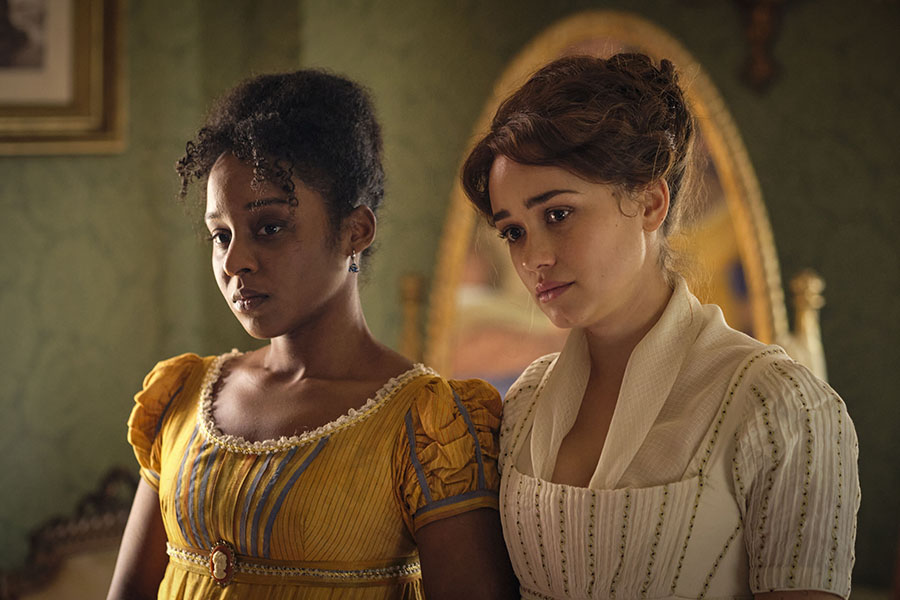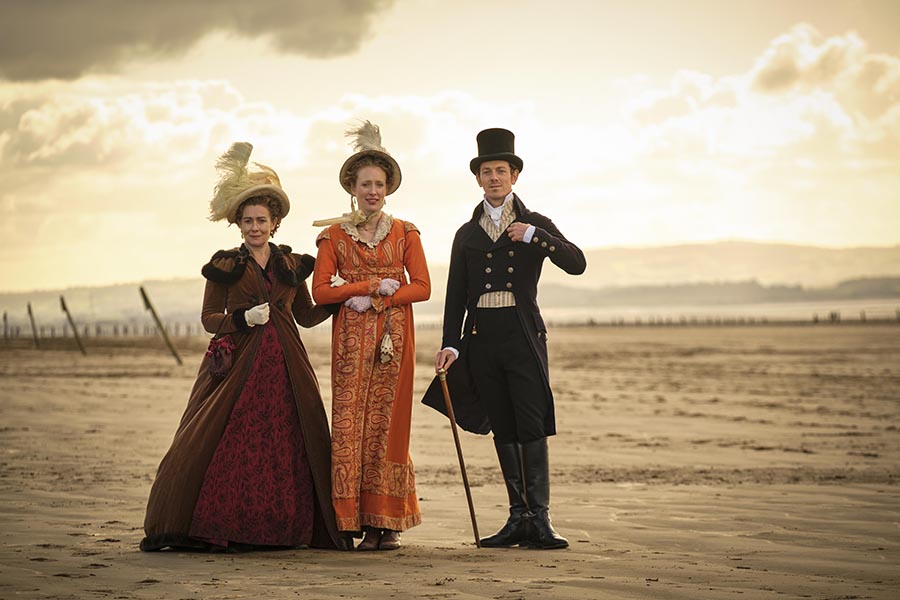How ‘Chevalier,’ ‘Sanditon,’ and ‘Queen Charlotte’ Are Addressing Diversity in Period Dramas on the Big and Small Screens

Hugh Sachs as Brimsley and Golda Rosheuvel as Queen Charlotte in 'Queen Charlotte: A Bridgerton Story,' which premieres on Netflix on May 4. Photo: Liam Daniel/Netflix © 2023
In the past few years #OscarSoWhite, Black Lives Matter and America’s heated debate over critical race theory has brought a reckoning around how we think about and discuss race. And that extends to Hollywood depictions in period dramas. Now, explicit discussion of history is unavoidable. For example, Britain (and the Royal Family in particular) played a major role in transatlantic slavery, so the relationship to the prized stately homes, titles and aristocratic estates is complicated by the fact that many are the spoils of a colonial era.
Diverse casting, too, is becoming a staple of the period drama. Jodie Turner-Smith’s turn as ill-fated Queen of England Anne Boleyn in the British miniseries Anne Boleyn is just one project in the genre that normalizes (albeit ahistorical) colour-blind casting, as progressive and racially-diverse audiences increasingly expect. Other projects incorporate lesser-known history, like 19th century Brooklyn’s thriving and well-established Black middle class as depicted in Julian Fellowes’s latest historical drama The Gilded Age.
When it comes to authentic truths about culture and history, not all diverse approaches to period casting are created equal. In the guise of costume drama, new projects — like Chevalier, Sanditon, and Queen Charlotte: A Bridgerton Story — are stepping up beyond colour-blind casting to anchor themselves in historical accuracy and address issues around race that resonate today.

Chevalier
Chevalier, a lush 18th century biopic that hit cinemas April 21, rewrites Black history back into history. It showcases the usual period trappings — rustling satins in macaron colours and the lavish candlelit lives of the courtier class. But its backward glance at pre-Revolutionary France is seen through a decidedly contemporary lens. The movie probes many pressing ideas around race and equal rights directly. It’s in the vein of real histories such as Britain’s first Black aristocrat Dido Belle, whose life is depicted in the 2014 movie Belle (and explored in Trinidadian writer Lawrence Scott’s historical novel Dangerous Freedom).
Written by Stefani Robinson and helmed by Canadian director Stephen Williams — the Jamaican-born, Emmy-winning director of Watchmen, Westworld and Ray Donovan — Chevalier tells the story of one of the first composers of African descent in classical music: Joseph Bologne, Chevalier de Saint-Georges (1745-1799). A violin virtuoso, conductor and champion fencer (Williams calls him “the Prince or Jimi Hendrix of his time”), he’s much lesser-known than contemporaries such as Mozart and Haydn and largely forgotten by history. The dashing Saint-George (here played by Kelvin Harrison Jr.) was the son of a Black woman enslaved to a French plantation owner in Guadeloupe and sent to France as a child for schooling in music and the gentlemanly arts with the exhortation to be unimpeachable at everything he does.
The movie opens with a vivid scene; a Black stranger shows up at a concert to challenge Mozart to a violin concerto duel — a string-off, if you will. Mozart assumes the man is a servant in borrowed finery and mocks him. What follows is the same thrilling, vivid call and response of a rap battle, each flourish of strings its own boast. Saint-Georges becomes a hit in courtly circles while torn between reconciling dual identities and being resented for his confidence as “uppity” — too Black yet never Black enough.
Even with his title of knight he doesn’t have the social capital to make society ignore that he is a Black man in a white French man’s world. The racist discrimination during his rise to musical fame and notoriety as he seeks the directorship of the Paris Opera — and a falling-out with his protector the Queen, Marie Antoinette (Lucy Boynton) — both contribute to his political awakening. However embellished for entertainment, his story puts the pull of assimilation into seldom-seen period context — refusing to incorporate the rhythmic stylings of his childhood and ancestry into his compositions, for example, or eventually shedding his powdered wig for cornrows. Saint-Georges went on to serve as a colonel in the first all-Black regiment in Europe and supported the abolitionist movement in France.
Chevalier’s pre-Revolutionary era marked the birth of the mass satirical and gossip press in France and, at the time, Saint-Georges and Marie-Josephine (Samara Weaving), wife of a titled military engineer, were rumoured to be having an affair. Yet, while the movie ups those romantic stakes and elides his life events (as many such biopics do) for the sake of dramatic arc, it’s not revisionist history. With the French Revolution looming, the layered themes of equality, identity and belonging in Chevalier are amplified to tackle the model minority myth and the burden of excellence head on. It’s far more authentic than simply inserting a character of colour into established white storylines that weren’t designed to explore their experience.
Sanditon
Set in the seaside resort town of Bath, Regency drama Sanditon (currently airing on PBS) is adapted from the unfinished final Jane Austen novel and features a West Indian heiress of mixed race. Austenian heroines Charlotte (Rose Williams) and Georgiana (Crystal Clarke), who plays the heiress, get equal billing — and screen time. That’s all the more notable because Sanditon was launched by Pride & Prejudice’s BBC creator Andrew Davies in 2019, well before representation in period dramas went mainstream (and also before more of the Austen family’s tangled relationship to slavery came to light in 2021).

Now in its third and final season, the series builds, in part, on the assertion that while Austen never publicly expressed her political opinions on race, she did so privately and also communicated her distaste for colonialism and slavery through characters and scenes in the novels Mansfield Park and Emma. It’s a complicated history: Austen’s father George was complicit in the legacy of British slave ownership on sugar plantations in Antigua, while her brother Henry was an activist in the abolition movement. (Similarly, the Jane Austen Museum in Chawton plans to educate visitors about the author’s connections to slavery.)
In a similar vein, Indian-born Freida Pinto and British Nigerian Sope Dìrísù (in the titular role) led the recent indie Regency courtship romp Mr. Malcolm’s List. The cast includes Theo James, Ashley Park and Zawe Ashton. Dìrísù’s character even speaks Yoruba at one point. “Why have I not connected with this much beforehand?,’” Dìrísù told IndieWire about the genre in a Zoom interview last year. “It was because of the absence of people who look like me.”
Though riffing on Jane Austen, Mr. Malcolm’s List packed more charms than yet another ironic, anodyne Persuasion remake. There are also nods to characters’ heritage in the costumes — for instance with Pinto’s paisley chintz dress textiles speaking volumes about what the British Empire took from India.

Bridgerton and Queen Charlotte: A Bridgerton Story
Queen Charlotte: A Bridgerton Story, the forthcoming Bridgerton spinoff prequel about the young queen’s early years (on Netflix May 4), will cover the Black queen’s courtship and marriage to King George, who is white. Nestled among the fancy balls and mannered courtship will be the origin story of Charlotte — Golda Rosheuvel’s vertiginously-coiffed queen bee from the main series, here played by India Amarteifio — and attempt to convey how their love story reverberated in fictional Britain enough to cause the complete breakdown of centuries-old racial barriers. It will presumably explain the societal shift depicted in the principal Bridgerton universe in ways the main series never does — the reality of race alongside themes of class and status — as a sort of soft power sprinkling of critical race theory in entertainment.
In the first season of Bridgerton — Shona Rhimes’s Netflix megahit based on the Julia Quinn romance novels — Lady Danbury (Adjoah Andoh) and the Duke of Hastings (Regé-Jean Paul) share a brief exchange alluding to a racial divide of the fictional setting’s recent past. “We were two separate societies divided by colour until a king fell in love with one of us,” she says. In flashbacks his father also admonishes him about the precarity of their position.
In season 2, Bridgerton introduced South Asian representation to the genre with the Sharma sisters. Yes, the whole thing is after all a Regency fantasy — emphasis on the fantasy and escapism — but Bridgerton depicts an improbable post-racial society where race is not a factor in the various courtships. It’s as though the idealistic union of the royals somehow solved racism and colonization had never existed.
We’ve previously written about how colour-blind casting isn’t enough, while culture writer Nylah Burton contends that it’s a trend that has “confusing disturbing political consequences.”
Period dramas like Sanditon and Queen Charlotte have begun to address the full context of the past, while Belle, and now Chevalier, excavate and probe the past. It’s a welcome start.
RELATED:
Bridgerton: Tracing the History of Gossip and Its Role in Social Connection
Take a Romantic Promenade Through Bridgerton U.K. Filming Locations